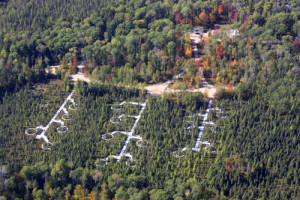
An aerial shot of the SPRUCE (Spruce-Peatland Response Under Climate and Environmental Change) site at the US Forest Service Marcell Experimental Forest in Minnesota.
While peatland ecosystems represent only up to five percent of the land surface, they sequester up to a third of soil organic carbon. Despite this important position in the biosphere much less is known about microbial communities and their functions in peatlands compared to most other terrestrial and ocean habitats. The net effects of increased temperature or decreased water availability in peatlands could drive significant changes in peatland carbon balances both directly and indirectly, shifting them from net carbon sinks to net carbon sources. Through this project, the researchers intend to create a resource for understanding the large-scale patterns of microbial community structure and function in peatland ecosystems, and to understand how these communities regulate carbon cycling in response to environmental change. Microbial communities involved in carbon cycling in peatlands have been characterized piecemeal via a variety of approaches, making a comprehensive understanding of community organization and comparison of communities among peatlands impossible.
Proposer’s Name: Erik Lilleskov